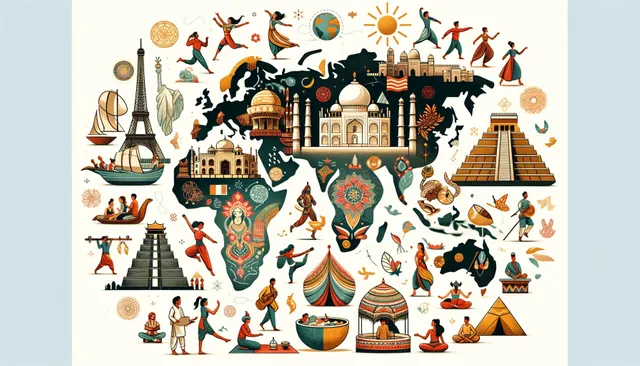Comparing Southern Asia vs. Other Regions of the World
🌏 Comparing Southern Asia vs. Other Regions of the World

Southern Asia, encompassing countries like India, Nepal, Bangladesh, Sri Lanka, and others, boasts a rich cultural heritage and distinct societal norms. This article provides a comparative overview of various aspects of civilization and respect towards others between Southern Asia and other regions of the world.
🏛 Civilization: Southern Asia vs. Other Regions
Southern Asia
- Ancient Civilizations: Harappan, Maurya, Gupta, Chola, Mughal.
- Cultural Heritage: Diverse languages, rich traditions, classical music, dance forms (Bharatanatyam, Kathak), traditional attire.
- Historical Contributions: Yoga, Ayurveda, mathematics (invention of zero), ancient universities (Nalanda, Takshashila).
- Architectural Marvels: Taj Mahal, Qutub Minar, Sigiriya, Anuradhapura.
- Respect for Diversity: Emphasis on pluralism, multi-religious coexistence, linguistic diversity.
Western World
- Ancient Civilizations: Greek, Roman, Celtic.
- Cultural Heritage: Renaissance art, classical music, modern art, traditional costumes (kilts, lederhosen).
- Historical Contributions: Democracy (Greece), law (Rome), Renaissance art and science, industrial revolution.
- Architectural Marvels: Pyramids of Giza, Colosseum, Eiffel Tower, Big Ben.
- Respect for Diversity: Varies widely by country, with some emphasizing multiculturalism (e.g., USA, Canada) and others more homogeneous.
Eastern Asia
- Ancient Civilizations: Chinese dynasties (Shang, Zhou, Han), Japanese Yamato period.
- Cultural Heritage: Calligraphy, tea ceremonies, martial arts (Kung Fu, Karate), traditional attire (kimono, hanbok).
- Historical Contributions: Confucianism, Taoism, Buddhism, papermaking, printing, gunpowder, and the compass.
- Architectural Marvels: Great Wall of China, Forbidden City, Himeji Castle, Gyeongbokgung Palace.
- Respect for Diversity: Emphasis on harmony and group conformity, respect for elders, hierarchical societies.
Western Asia
- Ancient Civilizations: Mesopotamia, Persian Empire, Ottoman Empire.
- Cultural Heritage: Persian poetry, Arabic calligraphy, Islamic architecture, traditional attire (abayas, dishdashas).
- Historical Contributions: Algebra, medical texts (Avicenna), architectural innovations (domes, arches), significant contributions to astronomy.
- Architectural Marvels: Persepolis, Hagia Sophia, Dome of the Rock.
- Respect for Diversity: Emphasis on hospitality and honor, religious tolerance varies widely by country.
Central Asia
- Ancient Civilizations: Silk Road cultures, Timurid Empire.
- Cultural Heritage: Nomadic traditions, yurt dwelling, traditional music (dombra), silk weaving.
- Historical Contributions: Silk Road trade, spread of technologies and culture, significant contributions to mathematics and astronomy.
- Architectural Marvels: Registan, Samarkand, ancient Silk Road cities.
- Respect for Diversity: Historically diverse due to Silk Road, modern-day emphasis on national identity, traditional clan systems.
🌟 Respect Towards Others: Southern Asia vs. Other Regions
Southern Asia
- Family Values: Strong emphasis on joint family systems, respect for elders, collective decision-making.
- Hospitality: Atithi Devo Bhava (Guest is God), elaborate rituals to welcome guests.
- Social Etiquette: Bowing or touching feet of elders, using honorifics, high-context communication.
- Conflict Resolution: Emphasis on harmony, mediation by elders, community involvement.
Western World
- Family Values: Nuclear families, individualism, varying degrees of respect for elders.
- Hospitality: Professional and courteous, but often more informal.
- Social Etiquette: Handshakes, casual greetings, direct communication.
- Conflict Resolution: Legal systems, individual negotiation, professional mediation.
Eastern Asia
- Family Values: Strong emphasis on family hierarchy, respect for elders, collective decision-making.
- Hospitality: Formal hospitality rituals, emphasis on respect and politeness.
- Social Etiquette: Bowing, use of honorifics, high-context communication.
- Conflict Resolution: Emphasis on harmony, mediation by elders or community leaders, avoidance of direct confrontation.
Western Asia
- Family Values: Strong family ties, respect for elders, patriarchal structures.
- Hospitality: High value on hospitality (e.g., Bedouin traditions), elaborate rituals to welcome guests.
- Social Etiquette: Handshakes, cheek kisses, elaborate greeting rituals.
- Conflict Resolution: Emphasis on honor, mediation by community or religious leaders, avoidance of public confrontation.
Central Asia
- Family Values: Clan-based systems, respect for elders, strong family ties.
- Hospitality: Emphasis on hospitality, traditional welcome ceremonies, offering food and shelter to guests.
- Social Etiquette: Handshakes, use of titles and honorifics, traditional greeting ceremonies.
- Conflict Resolution: Mediation by elders or community leaders, emphasis on harmony and respect.
🌍 Comparison of Best and Worst Practices
Southern Asia
- Best Practices: Rich cultural heritage, strong family values, high respect for elders, pluralistic societies.
- Worst Practices: Gender inequality in some regions, poverty issues, political instability in certain areas.
Western World
- Best Practices: Technological advancements, individual freedoms, democratic governance.
- Worst Practices: High levels of individualism leading to social isolation, historical colonialism impacts.
Eastern Asia
- Best Practices: Strong family ties, respect for education, technological innovation.
- Worst Practices: Rigid social hierarchies, pressure on individuals to conform, lack of individual expression.
Western Asia
- Best Practices: Hospitality, rich cultural heritage, significant historical contributions.
- Worst Practices: Political instability, human rights issues, gender inequality in some areas.
Central Asia
- Best Practices: Strong community ties, rich nomadic traditions, historical significance as part of the Silk Road.
- Worst Practices: Political corruption, economic challenges, limited individual freedoms.
Conclusion
This comparison highlights the diverse cultural practices and societal norms across different regions of the world. Southern Asia stands out for its rich cultural heritage, strong family values, and high respect for elders. Each region has its strengths and areas for improvement, and understanding these differences can foster greater global understanding and respect.
Congratulations, your post has been upvoted by @upex with a 0.98% upvote. We invite you to continue producing quality content and join our Discord community here. Visit https://botsteem.com to utilize usefull and productive automations #bottosteem #upex